University Biology Essay: Respiratory and Cardiac Systems Explained
VerifiedAdded on 2021/12/27
|6
|1336
|23
Essay
AI Summary
This essay provides an overview of the respiratory and cardiac systems, discussing the mechanisms of pulse rate and ventilation, the redistribution of blood during exercise, and the impact of circulatory and respiratory diseases. It delves into the regulatory processes of ventilation by chemoreceptors and pulse rate by sympathetic and parasympathetic stimulation. The essay explains blood redistribution during exercise through autoregulation and blood shunting, and it details the causes and environmental factors associated with circulatory diseases such as CAD and carotid artery disease. Furthermore, it examines the changes in the respiratory system during diseases like asthma and pneumonia, highlighting the relationship between respiratory diseases and environmental factors, including climate change and pollution, which can increase the prevalence of these conditions. The essay references several sources to support its claims.
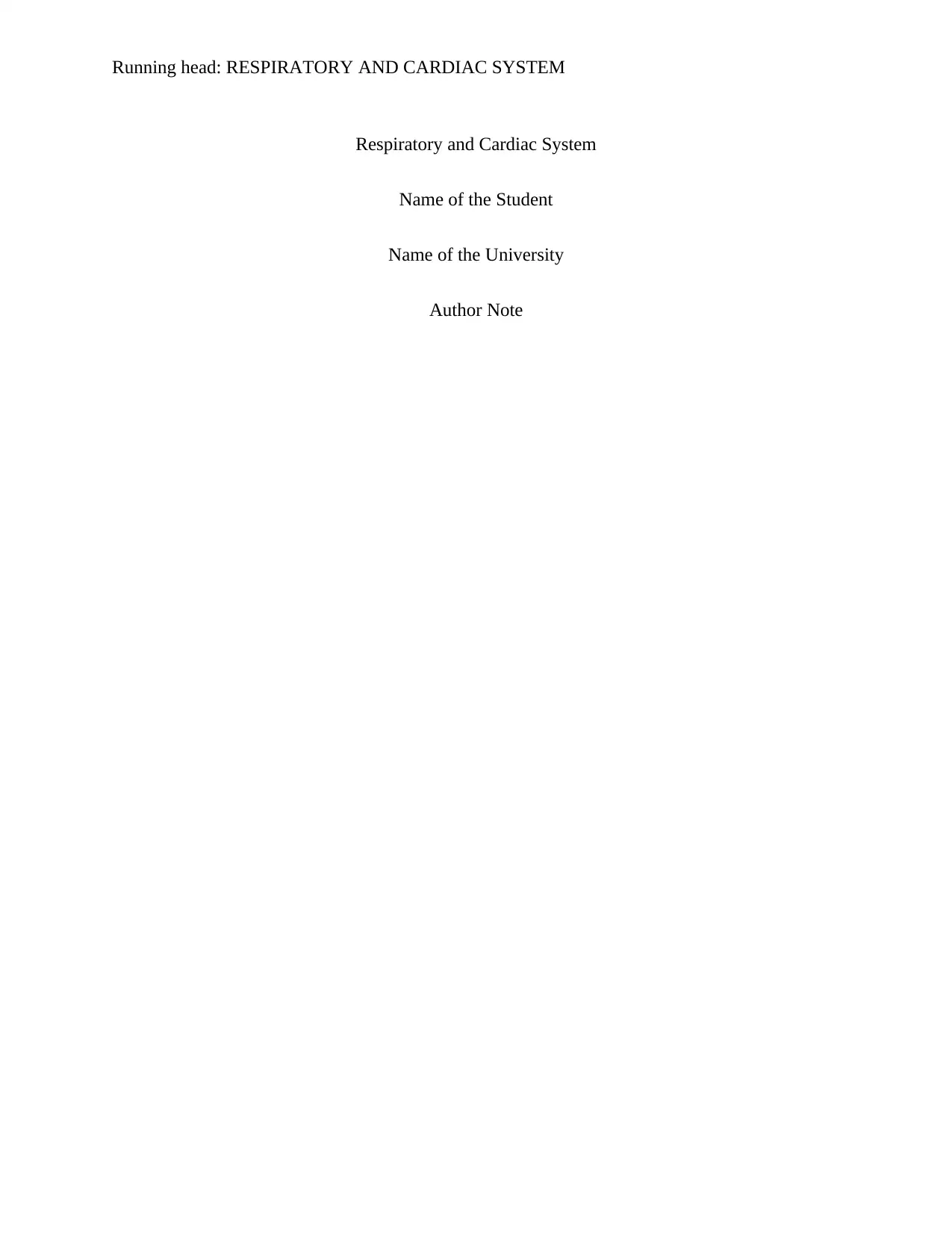
Running head: RESPIRATORY AND CARDIAC SYSTEM
Respiratory and Cardiac System
Name of the Student
Name of the University
Author Note
Respiratory and Cardiac System
Name of the Student
Name of the University
Author Note
Paraphrase This Document
Need a fresh take? Get an instant paraphrase of this document with our AI Paraphraser
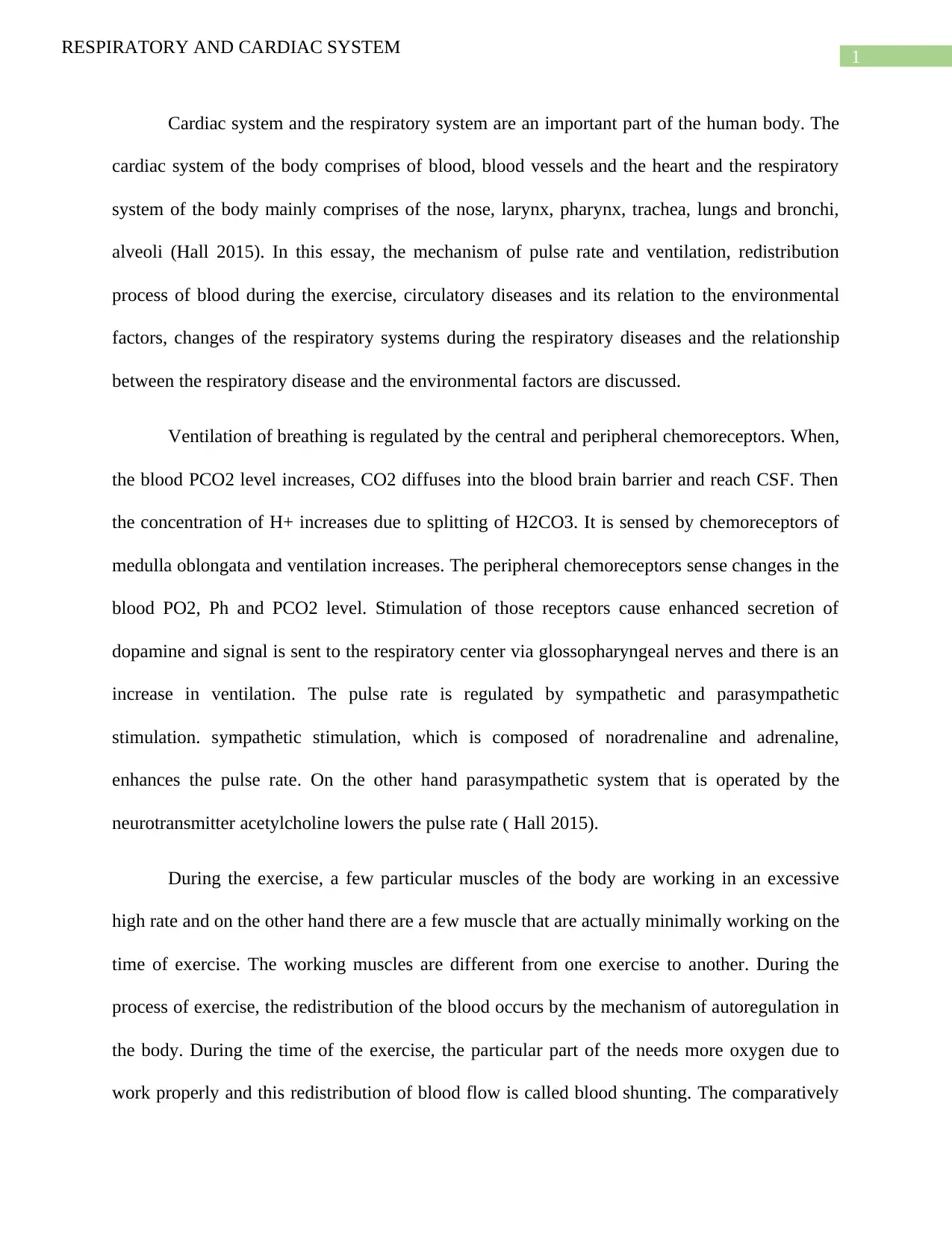
1RESPIRATORY AND CARDIAC SYSTEM
Cardiac system and the respiratory system are an important part of the human body. The
cardiac system of the body comprises of blood, blood vessels and the heart and the respiratory
system of the body mainly comprises of the nose, larynx, pharynx, trachea, lungs and bronchi,
alveoli (Hall 2015). In this essay, the mechanism of pulse rate and ventilation, redistribution
process of blood during the exercise, circulatory diseases and its relation to the environmental
factors, changes of the respiratory systems during the respiratory diseases and the relationship
between the respiratory disease and the environmental factors are discussed.
Ventilation of breathing is regulated by the central and peripheral chemoreceptors. When,
the blood PCO2 level increases, CO2 diffuses into the blood brain barrier and reach CSF. Then
the concentration of H+ increases due to splitting of H2CO3. It is sensed by chemoreceptors of
medulla oblongata and ventilation increases. The peripheral chemoreceptors sense changes in the
blood PO2, Ph and PCO2 level. Stimulation of those receptors cause enhanced secretion of
dopamine and signal is sent to the respiratory center via glossopharyngeal nerves and there is an
increase in ventilation. The pulse rate is regulated by sympathetic and parasympathetic
stimulation. sympathetic stimulation, which is composed of noradrenaline and adrenaline,
enhances the pulse rate. On the other hand parasympathetic system that is operated by the
neurotransmitter acetylcholine lowers the pulse rate ( Hall 2015).
During the exercise, a few particular muscles of the body are working in an excessive
high rate and on the other hand there are a few muscle that are actually minimally working on the
time of exercise. The working muscles are different from one exercise to another. During the
process of exercise, the redistribution of the blood occurs by the mechanism of autoregulation in
the body. During the time of the exercise, the particular part of the needs more oxygen due to
work properly and this redistribution of blood flow is called blood shunting. The comparatively
Cardiac system and the respiratory system are an important part of the human body. The
cardiac system of the body comprises of blood, blood vessels and the heart and the respiratory
system of the body mainly comprises of the nose, larynx, pharynx, trachea, lungs and bronchi,
alveoli (Hall 2015). In this essay, the mechanism of pulse rate and ventilation, redistribution
process of blood during the exercise, circulatory diseases and its relation to the environmental
factors, changes of the respiratory systems during the respiratory diseases and the relationship
between the respiratory disease and the environmental factors are discussed.
Ventilation of breathing is regulated by the central and peripheral chemoreceptors. When,
the blood PCO2 level increases, CO2 diffuses into the blood brain barrier and reach CSF. Then
the concentration of H+ increases due to splitting of H2CO3. It is sensed by chemoreceptors of
medulla oblongata and ventilation increases. The peripheral chemoreceptors sense changes in the
blood PO2, Ph and PCO2 level. Stimulation of those receptors cause enhanced secretion of
dopamine and signal is sent to the respiratory center via glossopharyngeal nerves and there is an
increase in ventilation. The pulse rate is regulated by sympathetic and parasympathetic
stimulation. sympathetic stimulation, which is composed of noradrenaline and adrenaline,
enhances the pulse rate. On the other hand parasympathetic system that is operated by the
neurotransmitter acetylcholine lowers the pulse rate ( Hall 2015).
During the exercise, a few particular muscles of the body are working in an excessive
high rate and on the other hand there are a few muscle that are actually minimally working on the
time of exercise. The working muscles are different from one exercise to another. During the
process of exercise, the redistribution of the blood occurs by the mechanism of autoregulation in
the body. During the time of the exercise, the particular part of the needs more oxygen due to
work properly and this redistribution of blood flow is called blood shunting. The comparatively
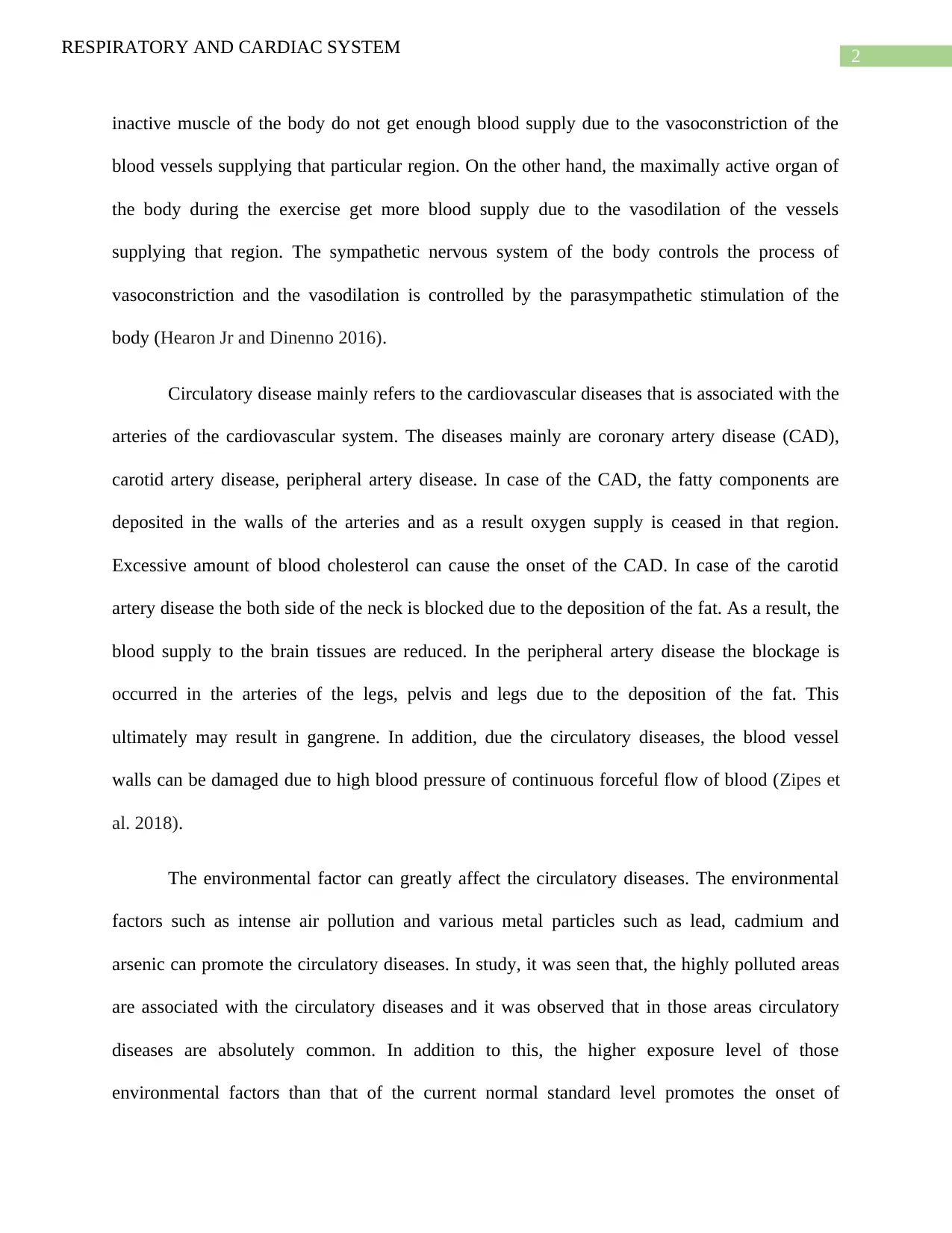
2RESPIRATORY AND CARDIAC SYSTEM
inactive muscle of the body do not get enough blood supply due to the vasoconstriction of the
blood vessels supplying that particular region. On the other hand, the maximally active organ of
the body during the exercise get more blood supply due to the vasodilation of the vessels
supplying that region. The sympathetic nervous system of the body controls the process of
vasoconstriction and the vasodilation is controlled by the parasympathetic stimulation of the
body (Hearon Jr and Dinenno 2016).
Circulatory disease mainly refers to the cardiovascular diseases that is associated with the
arteries of the cardiovascular system. The diseases mainly are coronary artery disease (CAD),
carotid artery disease, peripheral artery disease. In case of the CAD, the fatty components are
deposited in the walls of the arteries and as a result oxygen supply is ceased in that region.
Excessive amount of blood cholesterol can cause the onset of the CAD. In case of the carotid
artery disease the both side of the neck is blocked due to the deposition of the fat. As a result, the
blood supply to the brain tissues are reduced. In the peripheral artery disease the blockage is
occurred in the arteries of the legs, pelvis and legs due to the deposition of the fat. This
ultimately may result in gangrene. In addition, due the circulatory diseases, the blood vessel
walls can be damaged due to high blood pressure of continuous forceful flow of blood (Zipes et
al. 2018).
The environmental factor can greatly affect the circulatory diseases. The environmental
factors such as intense air pollution and various metal particles such as lead, cadmium and
arsenic can promote the circulatory diseases. In study, it was seen that, the highly polluted areas
are associated with the circulatory diseases and it was observed that in those areas circulatory
diseases are absolutely common. In addition to this, the higher exposure level of those
environmental factors than that of the current normal standard level promotes the onset of
inactive muscle of the body do not get enough blood supply due to the vasoconstriction of the
blood vessels supplying that particular region. On the other hand, the maximally active organ of
the body during the exercise get more blood supply due to the vasodilation of the vessels
supplying that region. The sympathetic nervous system of the body controls the process of
vasoconstriction and the vasodilation is controlled by the parasympathetic stimulation of the
body (Hearon Jr and Dinenno 2016).
Circulatory disease mainly refers to the cardiovascular diseases that is associated with the
arteries of the cardiovascular system. The diseases mainly are coronary artery disease (CAD),
carotid artery disease, peripheral artery disease. In case of the CAD, the fatty components are
deposited in the walls of the arteries and as a result oxygen supply is ceased in that region.
Excessive amount of blood cholesterol can cause the onset of the CAD. In case of the carotid
artery disease the both side of the neck is blocked due to the deposition of the fat. As a result, the
blood supply to the brain tissues are reduced. In the peripheral artery disease the blockage is
occurred in the arteries of the legs, pelvis and legs due to the deposition of the fat. This
ultimately may result in gangrene. In addition, due the circulatory diseases, the blood vessel
walls can be damaged due to high blood pressure of continuous forceful flow of blood (Zipes et
al. 2018).
The environmental factor can greatly affect the circulatory diseases. The environmental
factors such as intense air pollution and various metal particles such as lead, cadmium and
arsenic can promote the circulatory diseases. In study, it was seen that, the highly polluted areas
are associated with the circulatory diseases and it was observed that in those areas circulatory
diseases are absolutely common. In addition to this, the higher exposure level of those
environmental factors than that of the current normal standard level promotes the onset of
⊘ This is a preview!⊘
Do you want full access?
Subscribe today to unlock all pages.

Trusted by 1+ million students worldwide
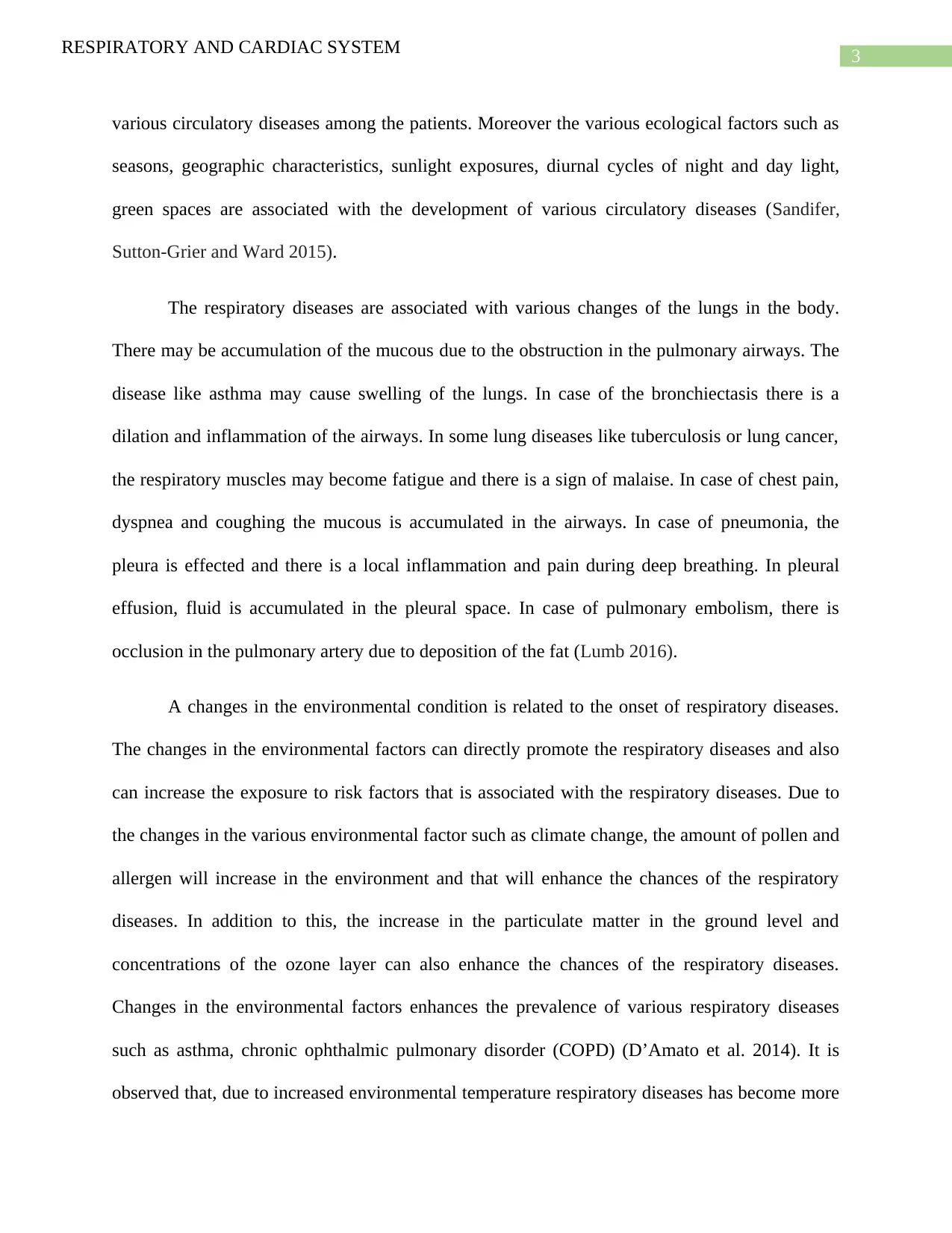
3RESPIRATORY AND CARDIAC SYSTEM
various circulatory diseases among the patients. Moreover the various ecological factors such as
seasons, geographic characteristics, sunlight exposures, diurnal cycles of night and day light,
green spaces are associated with the development of various circulatory diseases (Sandifer,
Sutton-Grier and Ward 2015).
The respiratory diseases are associated with various changes of the lungs in the body.
There may be accumulation of the mucous due to the obstruction in the pulmonary airways. The
disease like asthma may cause swelling of the lungs. In case of the bronchiectasis there is a
dilation and inflammation of the airways. In some lung diseases like tuberculosis or lung cancer,
the respiratory muscles may become fatigue and there is a sign of malaise. In case of chest pain,
dyspnea and coughing the mucous is accumulated in the airways. In case of pneumonia, the
pleura is effected and there is a local inflammation and pain during deep breathing. In pleural
effusion, fluid is accumulated in the pleural space. In case of pulmonary embolism, there is
occlusion in the pulmonary artery due to deposition of the fat (Lumb 2016).
A changes in the environmental condition is related to the onset of respiratory diseases.
The changes in the environmental factors can directly promote the respiratory diseases and also
can increase the exposure to risk factors that is associated with the respiratory diseases. Due to
the changes in the various environmental factor such as climate change, the amount of pollen and
allergen will increase in the environment and that will enhance the chances of the respiratory
diseases. In addition to this, the increase in the particulate matter in the ground level and
concentrations of the ozone layer can also enhance the chances of the respiratory diseases.
Changes in the environmental factors enhances the prevalence of various respiratory diseases
such as asthma, chronic ophthalmic pulmonary disorder (COPD) (D’Amato et al. 2014). It is
observed that, due to increased environmental temperature respiratory diseases has become more
various circulatory diseases among the patients. Moreover the various ecological factors such as
seasons, geographic characteristics, sunlight exposures, diurnal cycles of night and day light,
green spaces are associated with the development of various circulatory diseases (Sandifer,
Sutton-Grier and Ward 2015).
The respiratory diseases are associated with various changes of the lungs in the body.
There may be accumulation of the mucous due to the obstruction in the pulmonary airways. The
disease like asthma may cause swelling of the lungs. In case of the bronchiectasis there is a
dilation and inflammation of the airways. In some lung diseases like tuberculosis or lung cancer,
the respiratory muscles may become fatigue and there is a sign of malaise. In case of chest pain,
dyspnea and coughing the mucous is accumulated in the airways. In case of pneumonia, the
pleura is effected and there is a local inflammation and pain during deep breathing. In pleural
effusion, fluid is accumulated in the pleural space. In case of pulmonary embolism, there is
occlusion in the pulmonary artery due to deposition of the fat (Lumb 2016).
A changes in the environmental condition is related to the onset of respiratory diseases.
The changes in the environmental factors can directly promote the respiratory diseases and also
can increase the exposure to risk factors that is associated with the respiratory diseases. Due to
the changes in the various environmental factor such as climate change, the amount of pollen and
allergen will increase in the environment and that will enhance the chances of the respiratory
diseases. In addition to this, the increase in the particulate matter in the ground level and
concentrations of the ozone layer can also enhance the chances of the respiratory diseases.
Changes in the environmental factors enhances the prevalence of various respiratory diseases
such as asthma, chronic ophthalmic pulmonary disorder (COPD) (D’Amato et al. 2014). It is
observed that, due to increased environmental temperature respiratory diseases has become more
Paraphrase This Document
Need a fresh take? Get an instant paraphrase of this document with our AI Paraphraser
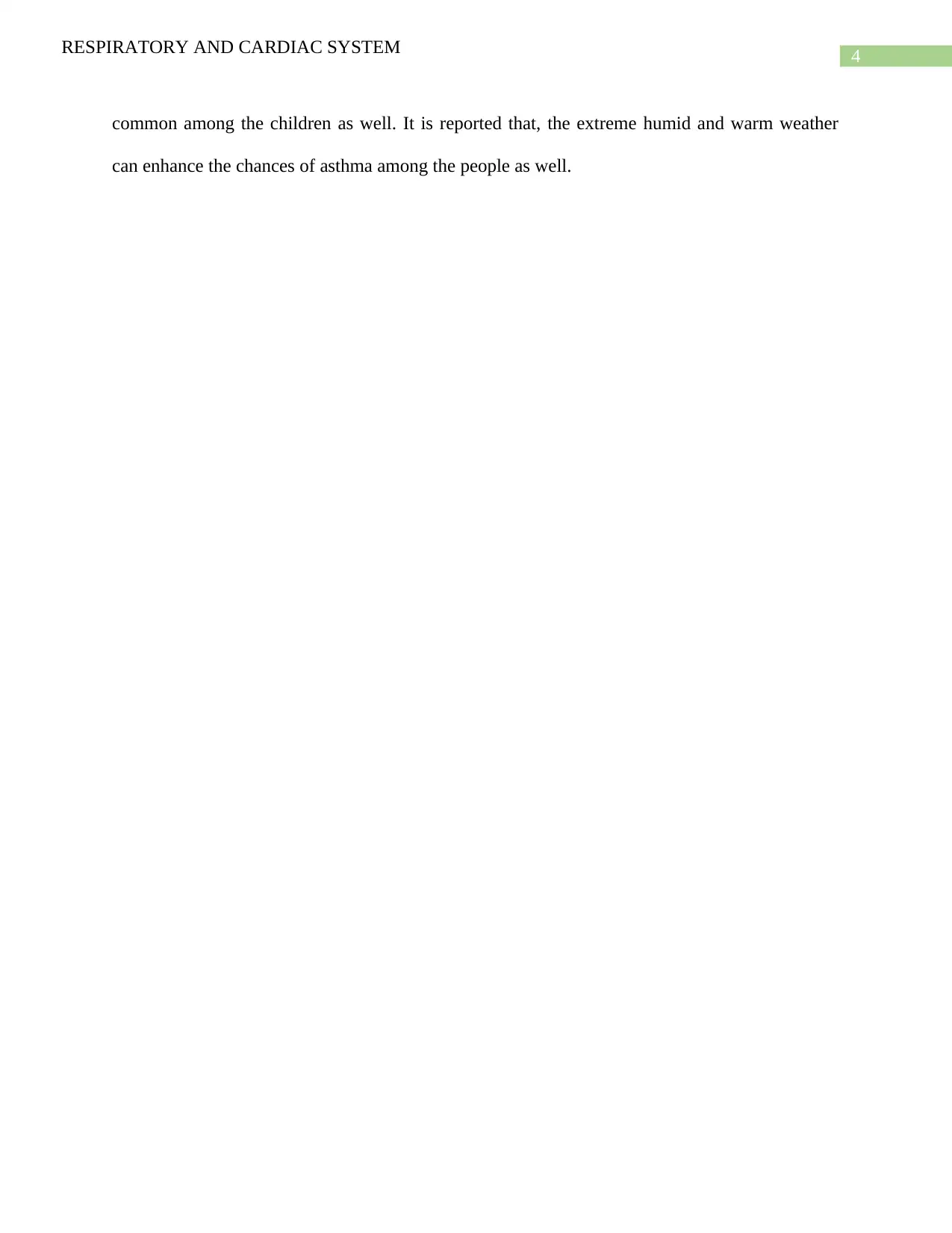
4RESPIRATORY AND CARDIAC SYSTEM
common among the children as well. It is reported that, the extreme humid and warm weather
can enhance the chances of asthma among the people as well.
common among the children as well. It is reported that, the extreme humid and warm weather
can enhance the chances of asthma among the people as well.
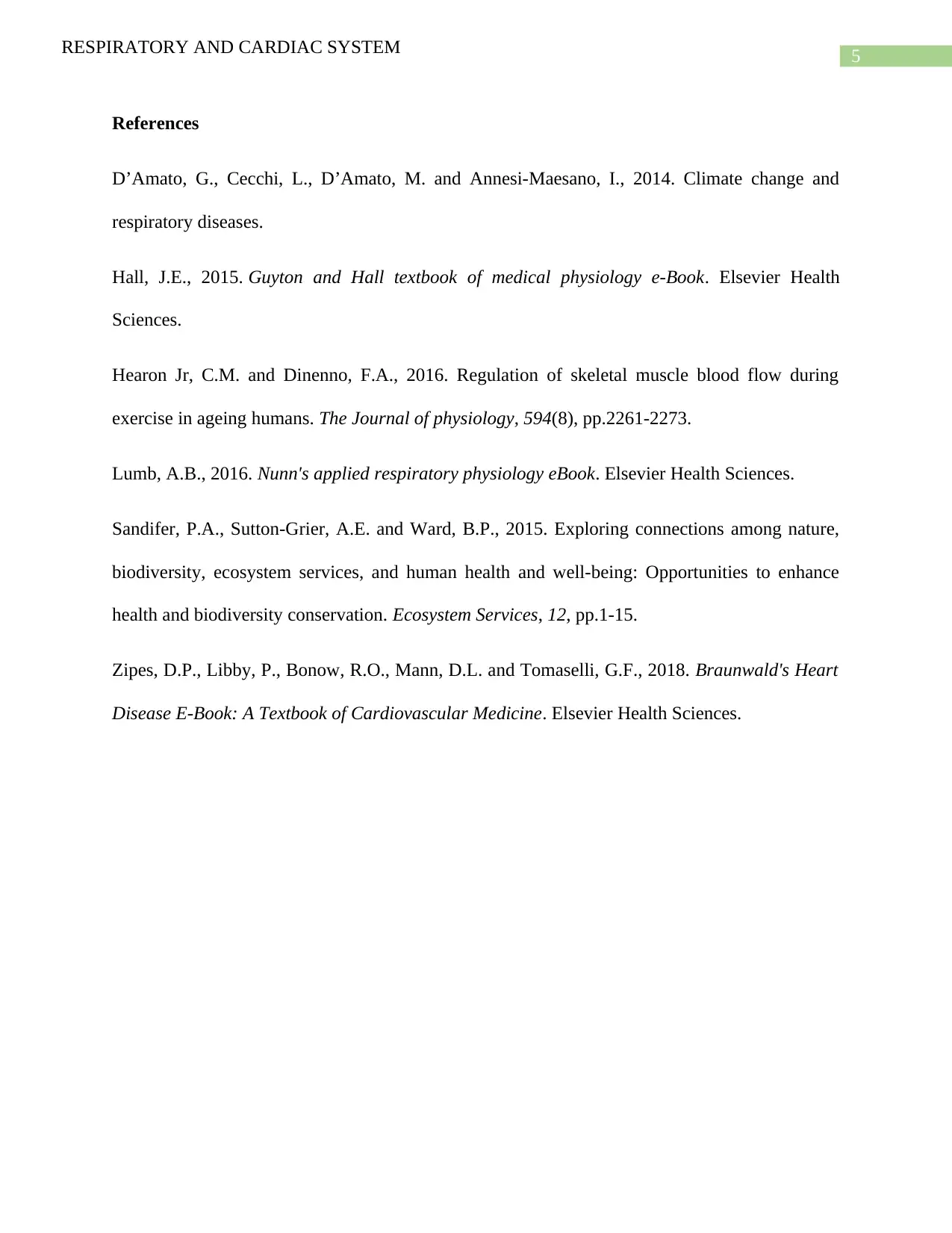
5RESPIRATORY AND CARDIAC SYSTEM
References
D’Amato, G., Cecchi, L., D’Amato, M. and Annesi-Maesano, I., 2014. Climate change and
respiratory diseases.
Hall, J.E., 2015. Guyton and Hall textbook of medical physiology e-Book. Elsevier Health
Sciences.
Hearon Jr, C.M. and Dinenno, F.A., 2016. Regulation of skeletal muscle blood flow during
exercise in ageing humans. The Journal of physiology, 594(8), pp.2261-2273.
Lumb, A.B., 2016. Nunn's applied respiratory physiology eBook. Elsevier Health Sciences.
Sandifer, P.A., Sutton-Grier, A.E. and Ward, B.P., 2015. Exploring connections among nature,
biodiversity, ecosystem services, and human health and well-being: Opportunities to enhance
health and biodiversity conservation. Ecosystem Services, 12, pp.1-15.
Zipes, D.P., Libby, P., Bonow, R.O., Mann, D.L. and Tomaselli, G.F., 2018. Braunwald's Heart
Disease E-Book: A Textbook of Cardiovascular Medicine. Elsevier Health Sciences.
References
D’Amato, G., Cecchi, L., D’Amato, M. and Annesi-Maesano, I., 2014. Climate change and
respiratory diseases.
Hall, J.E., 2015. Guyton and Hall textbook of medical physiology e-Book. Elsevier Health
Sciences.
Hearon Jr, C.M. and Dinenno, F.A., 2016. Regulation of skeletal muscle blood flow during
exercise in ageing humans. The Journal of physiology, 594(8), pp.2261-2273.
Lumb, A.B., 2016. Nunn's applied respiratory physiology eBook. Elsevier Health Sciences.
Sandifer, P.A., Sutton-Grier, A.E. and Ward, B.P., 2015. Exploring connections among nature,
biodiversity, ecosystem services, and human health and well-being: Opportunities to enhance
health and biodiversity conservation. Ecosystem Services, 12, pp.1-15.
Zipes, D.P., Libby, P., Bonow, R.O., Mann, D.L. and Tomaselli, G.F., 2018. Braunwald's Heart
Disease E-Book: A Textbook of Cardiovascular Medicine. Elsevier Health Sciences.
⊘ This is a preview!⊘
Do you want full access?
Subscribe today to unlock all pages.

Trusted by 1+ million students worldwide
1 out of 6
Related Documents
Your All-in-One AI-Powered Toolkit for Academic Success.
+13062052269
info@desklib.com
Available 24*7 on WhatsApp / Email
![[object Object]](/_next/static/media/star-bottom.7253800d.svg)
Unlock your academic potential
Copyright © 2020–2025 A2Z Services. All Rights Reserved. Developed and managed by ZUCOL.





